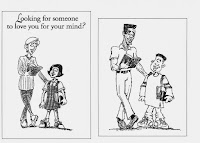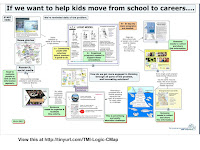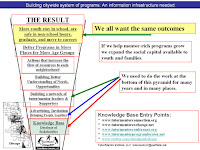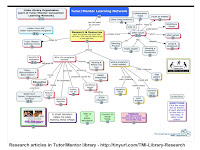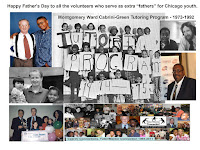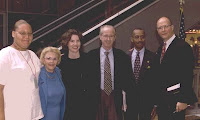This is the fourth in a series of
decade-ending articles I’m posting to show the work we’ve done in the past decade and the challenges we’ve overcome.
As you read today’s article, I encourage you to read some of these articles showing the
value of informal networks, and how expanded
social capital influences behavior. Also read some of these articles about
collaboration and
network building.

Our aim is to connect inner city youth with volunteers in structured, non-school tutor/mentor programs. When we launched
Cabrini Connections in 1993 we had seven volunteers and no money. There was a perception among many that there already were too many youth programs in Chicago. How were we going to find the money, volunteers and ideas needed to build our own organization into one that had a life-changing impact on teens and volunteers if we could not find the resources to do this?
At the same time, my
17 year history of leading the tutor/mentor program at Montgomery Ward, and networking with peers, had convinced me that no one had a master database of tutor/mentor programs, and thus no one was able to encourage networking and idea sharing, or create advertising-based marketing strategies that could help tutor/mentor programs grow in every high poverty neighborhood.
In January 1994 we launched the
Tutor/Mentor Connection survey to determine what programs were in Chicago, what type of tutoring and/or mentoring they offered, what age group they serve and where they were located. We’ve been mapping this information since then. I
wrote about this on Monday.
120 programs responded to the first survey, telling us they offered some form of tutoring and/or mentoring. 54% said they had “little or no contact with peers” and over 70% said they would like more contact. 90% said they would attend a conference if it fit their schedule and was at low/no cost.
Thus, we organized a conference in May 1994, asking programs in the database to talk about what they do, and how they recruit and train volunteers. Catholic Charities on LaSalle Street in Chicago donated space. 70 people attended. We published our first Directory, and also launched a partnership with the
Lend A Hand Program at the Chicago Bar Foundation to help raise dollars to fund tutor/mentor programs in Chicago.

Enough people felt this first conference was a good idea that we launched a 2nd conference in November 1994 at the Shedd Aquarium and 200 people attended. We continued the May and November schedule of conferences through the 1990s with a maximum of 350 people attending in May 1999 when State Senator Barack Obama and Congressmen Louis Gutierrez were speakers. Mayor Richard Daley and Congressman Danny Davis have also spoke at
past conferences. So did Paul Vallas. Our partnership with the
Lend A Hand Program also grew, and the LAH used the May conference each year to pass out small grants to tutor/mentor programs.

The conferences were not just a couple of days for networking and sharing ideas. They were part of an annual event strategy aimed at creating greater news coverage of tutoring/mentoring programs, which would draw more volunteers and donors to the different programs operating in Chicago.
This chart shows the quarterly events that were developed during the 1990s to support this strategy.

While the first conferences were organized in 1994, an
August/September Volunteer Recruitment Campaign was added in 1995. A Tutor/Mentor Week event was also launched in 1994, with the Lend A Hand Program at the Chicago Bar Foundation taking the lead in obtaining a proclamation from the Mayor of Chicago declaring Tutor/Mentor Week. By 1998 the Lend A Hand Program and Chicago Bar Foundation were organizing a November event at Chicago Museums that was attracting over 1500 guests.

The T/MC was selected to be one of 50
Teaching Examples at the 1997 President’s Summit for America’s Future, held in Philadelphia. Each year these events led to TV, Radio and Newspaper interviews where T/MC talked about the need for tutor/mentor programs in all Chicago high poverty neighborhoods, not just its own Cabrini Connections program.
Then came the Decade of Doom and Gloom (my name for the 2000s). This chart shows conference attendance since 2000. While we reached 450 or more people in 2000-2002 participation has ranged from 225 to 350 since then.

This chart shows funds that have been available from 2000 to 2010 to support all of the work of the Tutor/Mentor Connection, including the conferences. Without funds to rent space for the conferences, T/MC was often left with little time to recruit speakers and promote the conferences. Without dollars for marketing, T/MC was not able to print and mail newsletters and invitation brochures.

All conferences since 2000 have been organized and promoted totally by email networking.
Yet while attendance had declined, the conferences are still drawing participants from throughout the Chicago region at this map of the May 2008 conference shows.

The conferences have always depended on the participation of people from other programs in Chicago and beyond, who volunteer their time to be speakers and participate in panels.
Fifty-six organizations have attended five or more conferences between 2000 and 2009. Big Brothers Big Sisters of Metropolitan Chicago, East Village Youth Program, Associated Colleges of Illinois, Family Matters, Juvenile Court Mentoring Network, Midtown/Metro and Chicago Lights Tutoring Program each attended more than half the conferences during this period.
In this video leaders show why they participate in these conferences.
Conference Capacity from Cabrini Connections on Vimeo.
This is
another video showing what conference participants say about participating. This page has a list of speakers and workshops from
conferences offered in the past decade.
With the help of software donated by Valdis Krebs of
Orgnet, who spoke at the
November 2009 conference, T/MC has begun to map the participation of past conferences. This map shows attendees of 2008 conferences. See more maps like this at
Conference SNA Blog.

This
analysis shows the feedback from the most recent conference in November 2010.

The conferences are also attracting participants from other cities and states. Speakers and participants come from Milwaukee, California,Iowa, New York, Ohio and many other states. We've already been contacted by a group from Canada that wants to present information in 2011. In 2000 the conference hosted leaders from the Hospital Youth Mentoring Network. This photo shows leaders from the University of Toledo at one of the conferences.

In August 2010 Dan Bassill was the keynote speaker at a
Mentoring Summit held in Indianapolis, organized as a result of participation in the Chicago conferences since 2000. The
T/MC main web site was built by the technology department of IUPUI in 2005 as a result of networking from the conference.
Thus while we have drawn fewer people to face-to-face conferences during the past decade, we’ve helped hundreds, perhaps thousands, of people connect with others and learn ideas that they can use in their own organizations.
We’ve also expanded our use of on-line forums to connect and share ideas.
At
http://tutormentorconnection.ning.com we have more than 300 members. I’m connected to more than 500 people on my Linked in and Facebook pages, including more than 100 former students of Cabrini Connections.
By participating in forums at
http://www.socialedge.org ,
Fireside Learning,
Learning to Finish,
Mentoring Forums and others, we are reaching countless other people who will never come to the Chicago conference but who can benefit from T/MC ideas and the ideas we share on our web sites.
Thus, while the past decade has made it difficult to organize and market the May and November Tutor/Mentor Leadership and Networking Conferences, we have done a lot of network building with a small amount of funding.Yet, what
might be possible if T/MC had a half-million or a million dollars a year to support its market-research, network building, information sharing and advertising advocacy and fund raising for tutor/mentor programs in Chicago?
Read
past articles about Tutor/Mentor Conferences
Read
blog exchange articles and see another way we connect and share ideas with others.
Next article will focus on network building.

